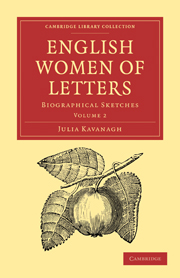Summary
Towards the middle of the eighteenth century the farm of Standingfield, near Bury St. Edmunds, in Suffolk, was held by a Catholic family named Simpson. Here, on the 15th of October, 1753, Elizabeth Simpson was born. She was one of eight children, and, like her four sisters, remarkable for great beauty. She received the narrow education which her sex and station in life rendered adequate according to the feeling of the times, but she read a great deal, and early acquired a passion for the stage, which ran through the whole family. George Simpson became an actor; Mrs. Simpson, when she took her daughters to Bury, also took them to the play, and even to rehearsals, and Elizabeth was not eighteen when she secretly wrote to the manager of the Norwich theatre to ask him for an engagement. A strange proposal, when we consider that this would-be actress was not only totally untaught? but had even an impediment in her speech, which she retained through life. But it was not merely the stage Elizabeth Simpson longed for, she wanted to see the world, “and would rather have died than not do so,” as she declared in her thirteenth year. She also had a romantic feeling for the Norwich manager, Mr. Griffith; but, though he gave her polite replies, he did not assist her materially. Elizabeth at length took a desperate resolve.
- Type
- Chapter
- Information
- English Women of LettersBiographical Sketches, pp. 1 - 44Publisher: Cambridge University PressPrint publication year: 2010First published in: 1863



